Design of Diaphragm and Coil for Stable Performance of an Eddy Current Type Pressure Sensor
Abstract
:1. Introduction
2. Principle and Structure of Eddy Current Type Pressure Sensor
2.1. Working Principle of a Typical Pressure Sensor
2.2. Structure of Eddy Current Type Pressure Sensor
3. Design of Sensor Coil
3.1. Design Parameters
3.2. Signal Processing for Eddy Current Detection
3.3. Experiment Evaluation of Sensor Coil
4. Design of Round-Grooved Diaphragm
4.1. Shape of Diaphragm for Stably Measurable Deflection
4.2. Analysis of Diaphragm Deflection
5. Sensor Performance Evaluation through Pressure Measurement Test
5.1. Measurements of Diaphragm Deflection According to Applied Pressure
5.2. Assembled Pressure Sensor
5.3. Performance Evaluation of an Assembled Pressure Sensor According to Applied Pressure
6. Conclusions
- (1)
- The coil designed in this research has a good linear relationship between the impedance change and the distance to target plate up to 500 μm.
- (2)
- A round-grooved diaphragm is much better for stable measurement of deflection even with much less deflection compared to a flat type one.
- (3)
- Depending on the required pressure and sensitivity measurement, the design parameters of a round-grooved diaphragm can be selected.
- (4)
- The developed sensor shows a very good linearity up to 10 MPa with linearity errors less than 0.16%.
Acknowledgments
Author Contributions
Conflicts of Interest
References
- David, R.R. Engine Combustion: Pressure Measurement and Analysis; SAE International: Warrendale, PA, USA, 2010. [Google Scholar]
- André, V.B.; José, A.V.; Luiz, F.M. Chapter 2: Internal Combustion Engine Indicating Measurements. In Applied Measurement Systems; Zahurul, H., Ed.; InTech: Rijeka, Croatia, 2012; pp. 23–44. [Google Scholar]
- Perraud, E. Theoretical model of performance of a silicon piezoresistive pressure sensor. Sens. Actuator. A Phys. 1996, 57, 245–252. [Google Scholar] [CrossRef]
- Barlian, A.A.; Park, W.T.; Mallon, J.R.; Rastegar, A.J.; Pruitt, B.L. Review: Semiconductor piezoresistance for microsystems. IEEE Proc. 2009, 97, 513–552. [Google Scholar] [CrossRef] [PubMed]
- Kim, J.C.; Lee, J.C.; Choi, B.K. Fabrication and characterization of strain gauge integrated polymeric diaphragm pressure sensors. Int. J. Precis. Eng. Manuf. 2013, 14, 2003–2008. [Google Scholar] [CrossRef]
- Berg, J.V.; Ziermann, R.; Reichert, W.; Obermeier, E.; Eickhoff, M.; Krotz, G. Measurement of the cylinder pressure in combustion engines with a piezoresistive β-SiC-on-SOI pressure sensor. In Proceeding of the 1998 High Temperature Electronics Conference, Albuquerque, NM, USA, 14–18 June 1998; pp. 245–249.
- Otmani, R.; Benmoussa, N.; Benyoucef, B. The thermal drift characteristics of piezoresistive pressure sensor. Phys. Proced. 2011, 21, 47–52. [Google Scholar] [CrossRef]
- Li, Q; Ding, F. Novel displacement eddy current sensor with temperature compensation for electro hydraulic valves. Sens. Actuator. A Phys. 2005, 122, 83–87. [Google Scholar] [CrossRef]
- Wang, H.; Feng, Z. Ultrastable and highly sensitive eddy current displacement sensor using self-temperature compensation. Sens. Actuator. A Phys. 2013, 203, 362–368. [Google Scholar] [CrossRef]
- Kim, T.O.; Lee, G.S.; Kim, H.Y.; Ahn, J.H. Modeling of eddy current sensor using geometric and electromagnetic data. J. Mech. Sci. Technol. 2007, 21, 488–498. [Google Scholar] [CrossRef]
- Nabavi, M.R.; Nihtianov, S.N. Design strategies for eddy-current displacement sensor systems: Review and recommendations. IEEE Sens. J. 2012, 12, 3346–3355. [Google Scholar] [CrossRef]
- Wang, F.; Shao, Z.; Xie, J.; Hu, Z.; Luo, H.; Hu, Y. Extrinsic fabry-perot underwater acoustic sensor based on micromachined center-embossed diaphragm. J. Lightwave Technol. 2014, 32, 4628–4636. [Google Scholar] [CrossRef]

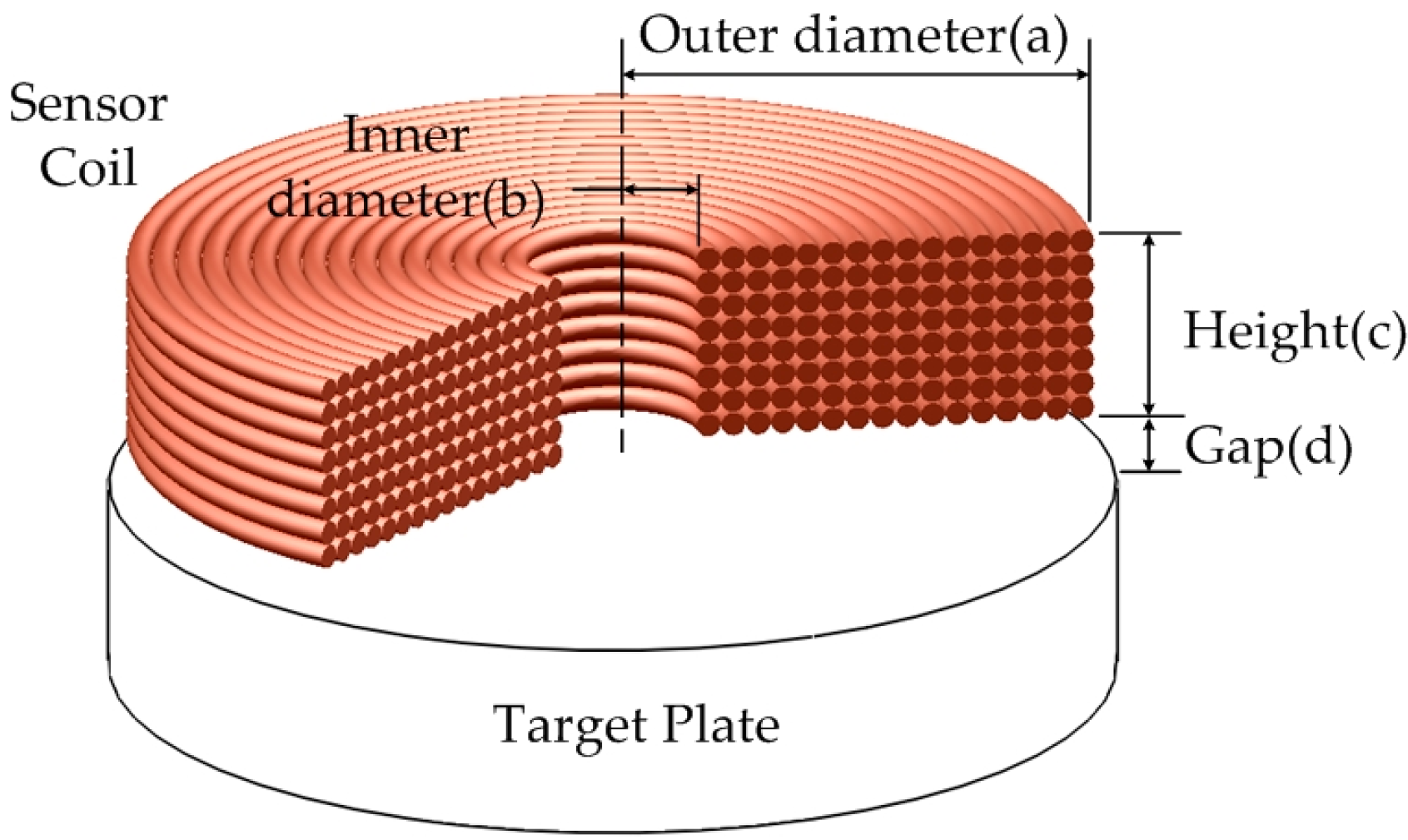
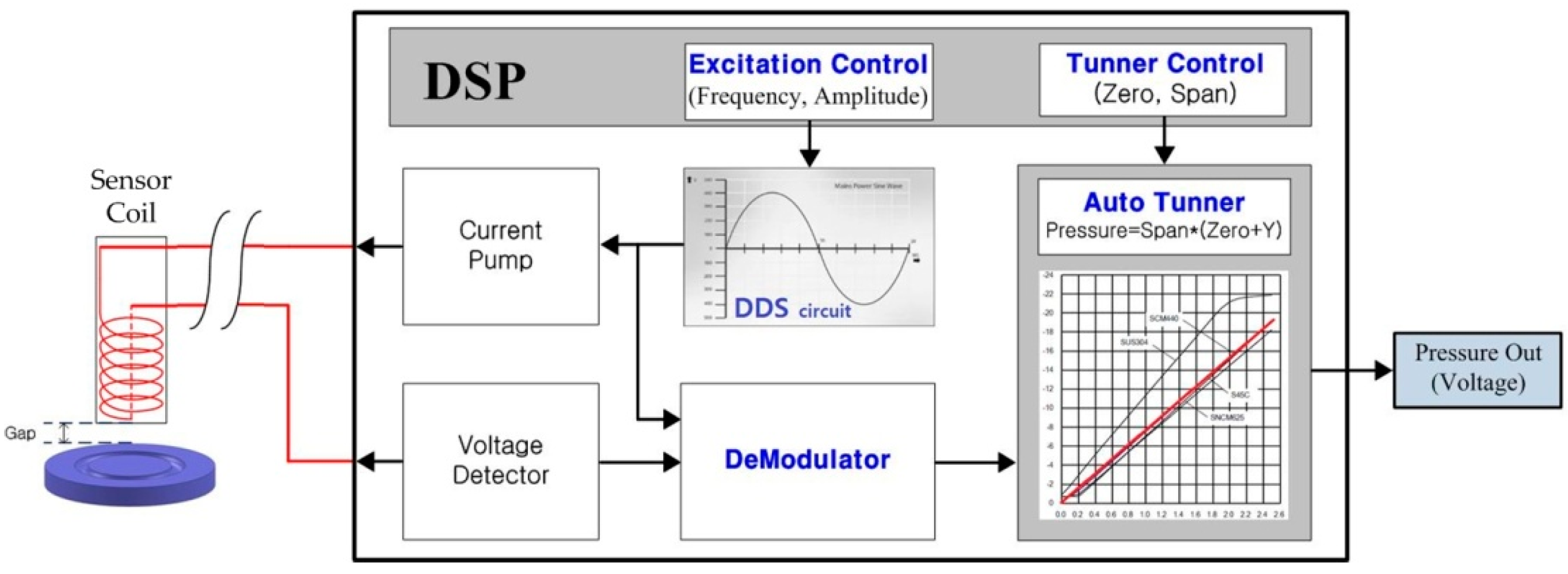
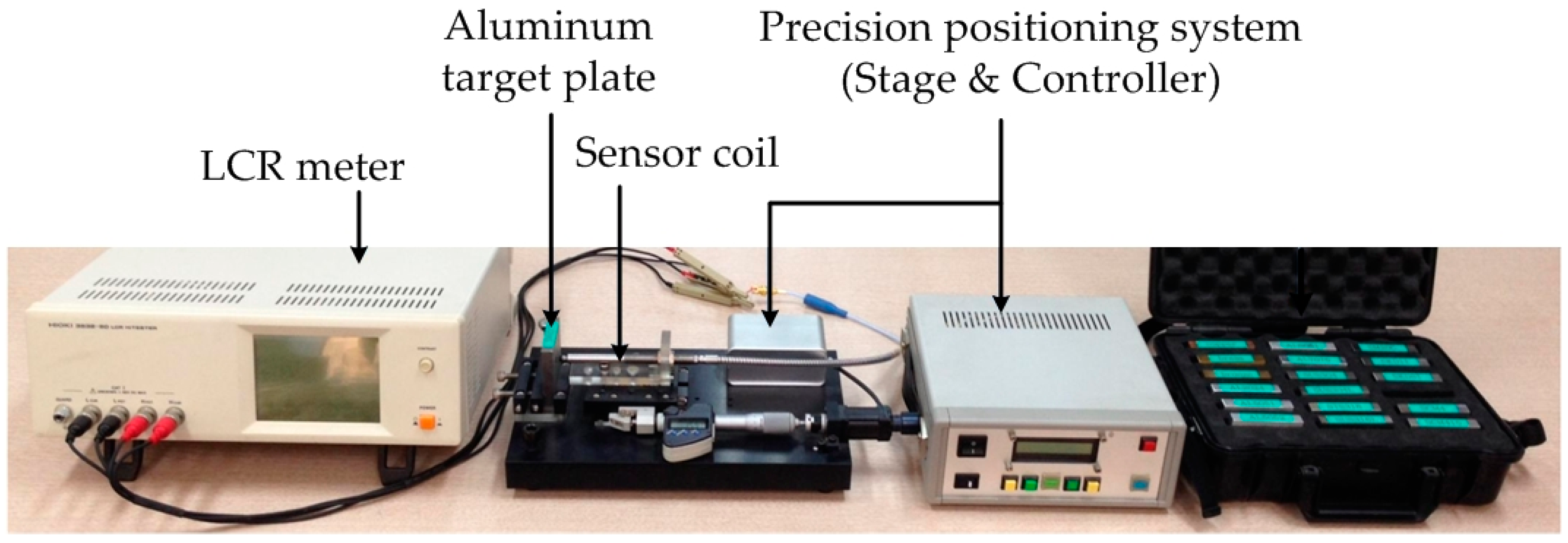
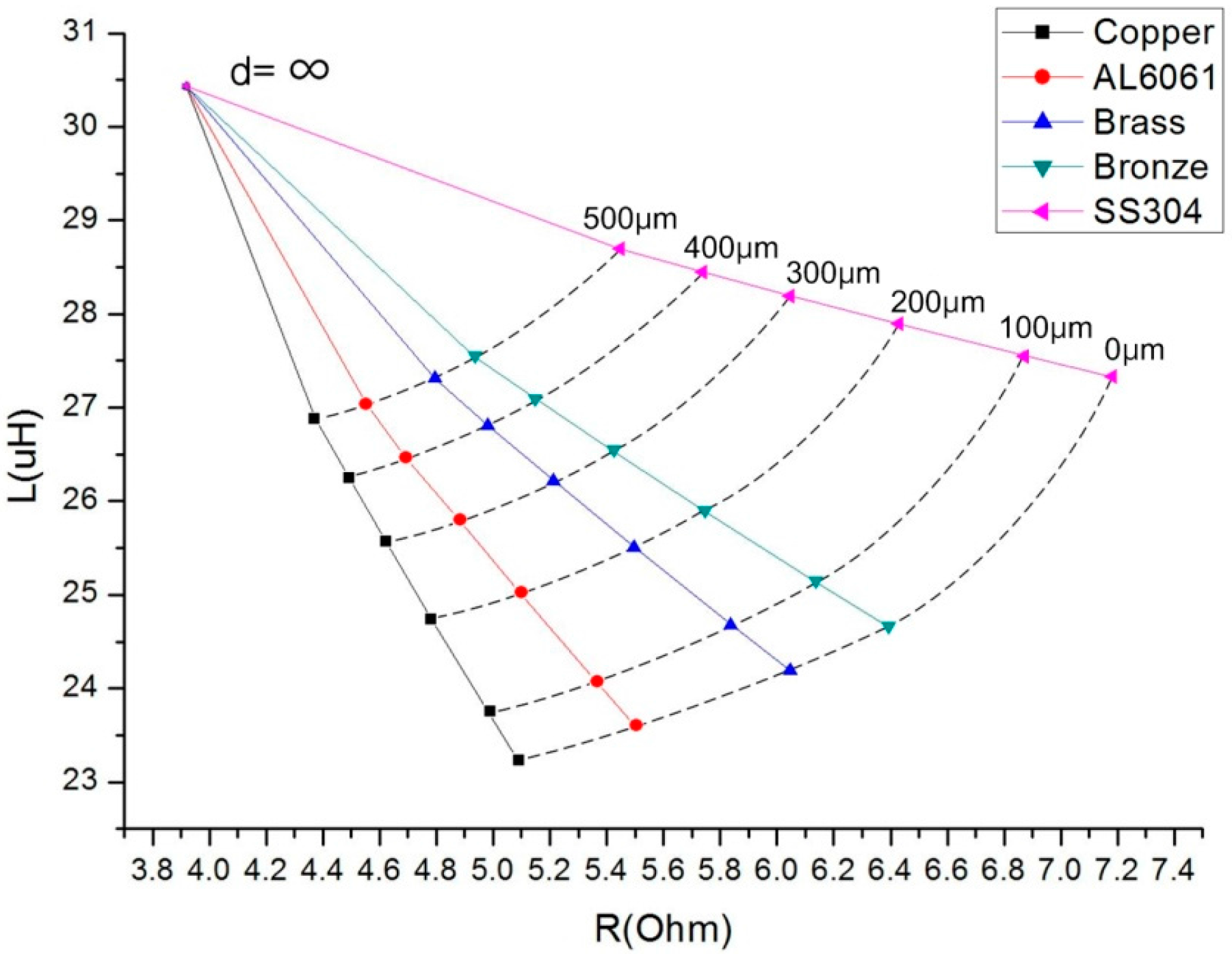

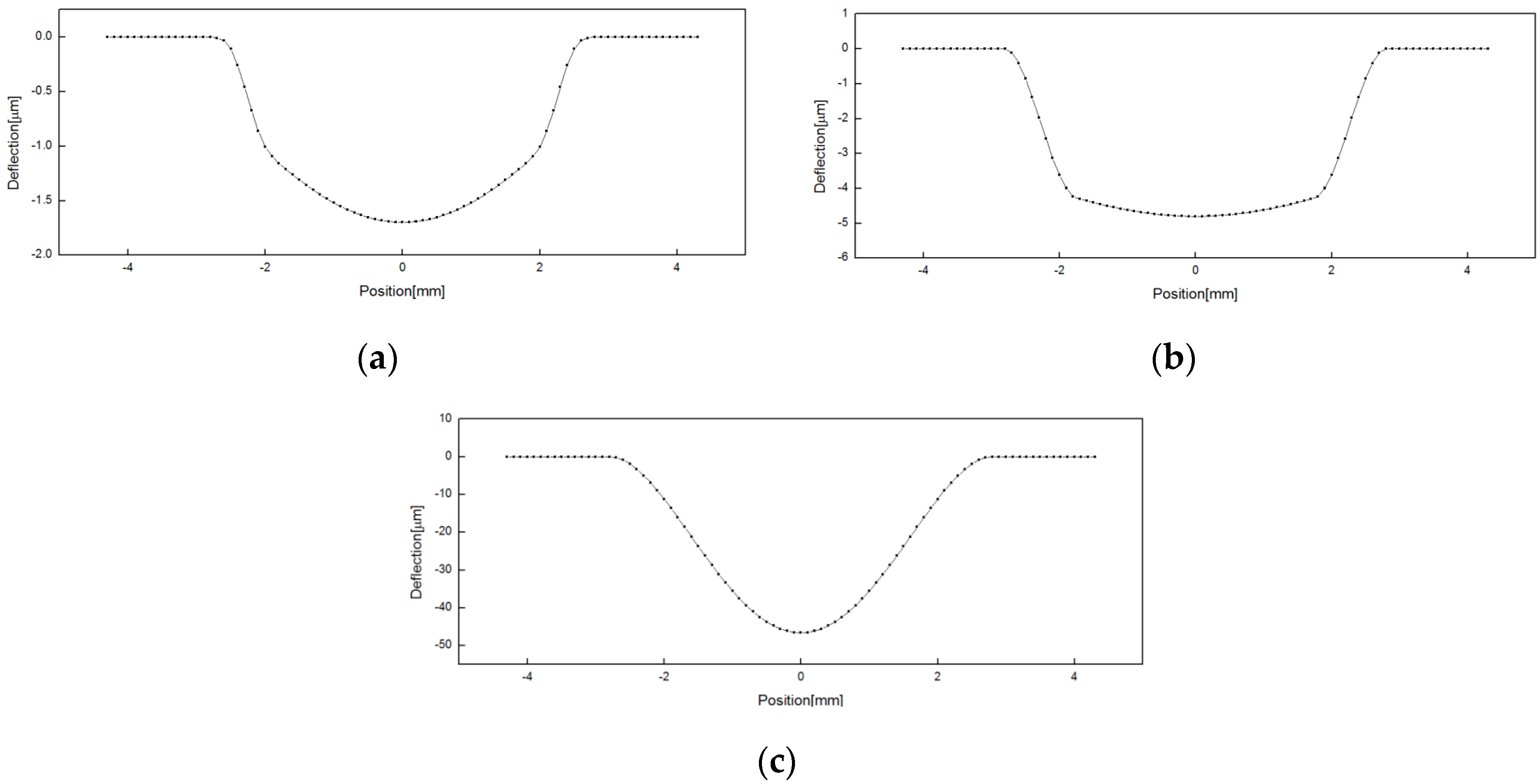
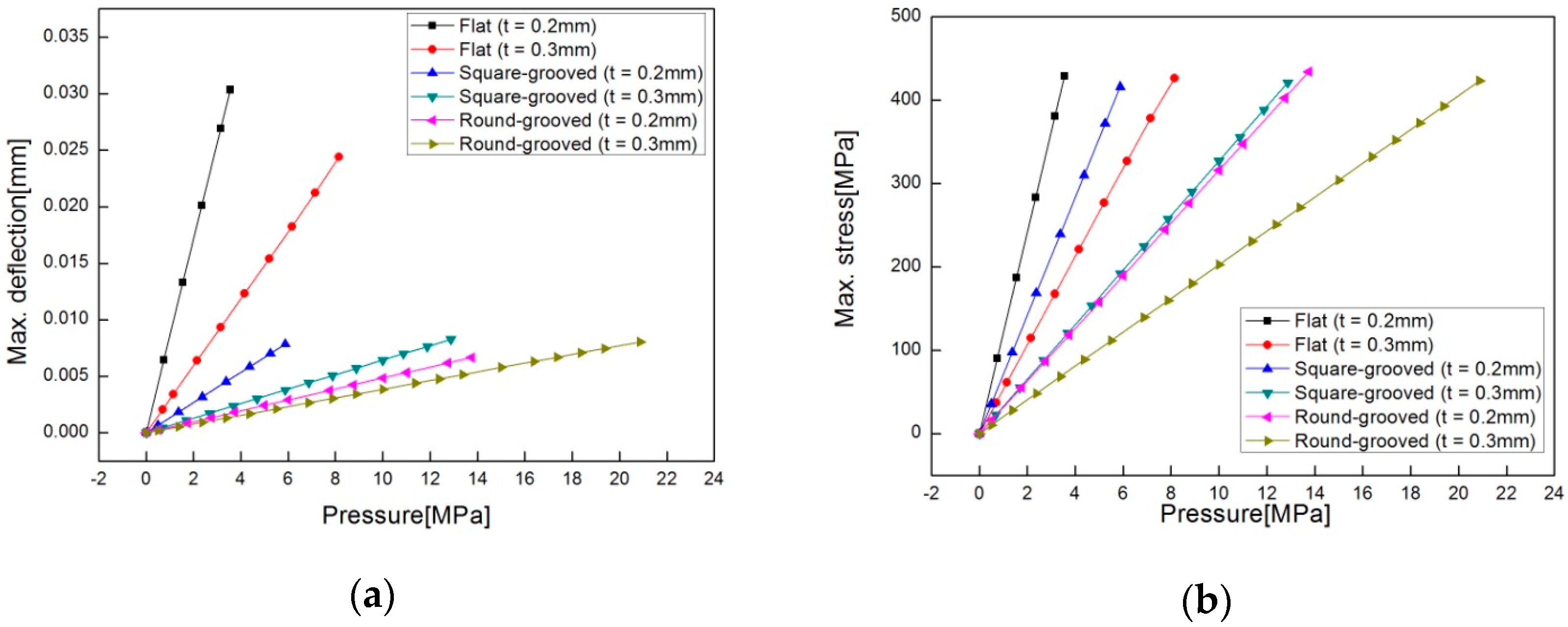
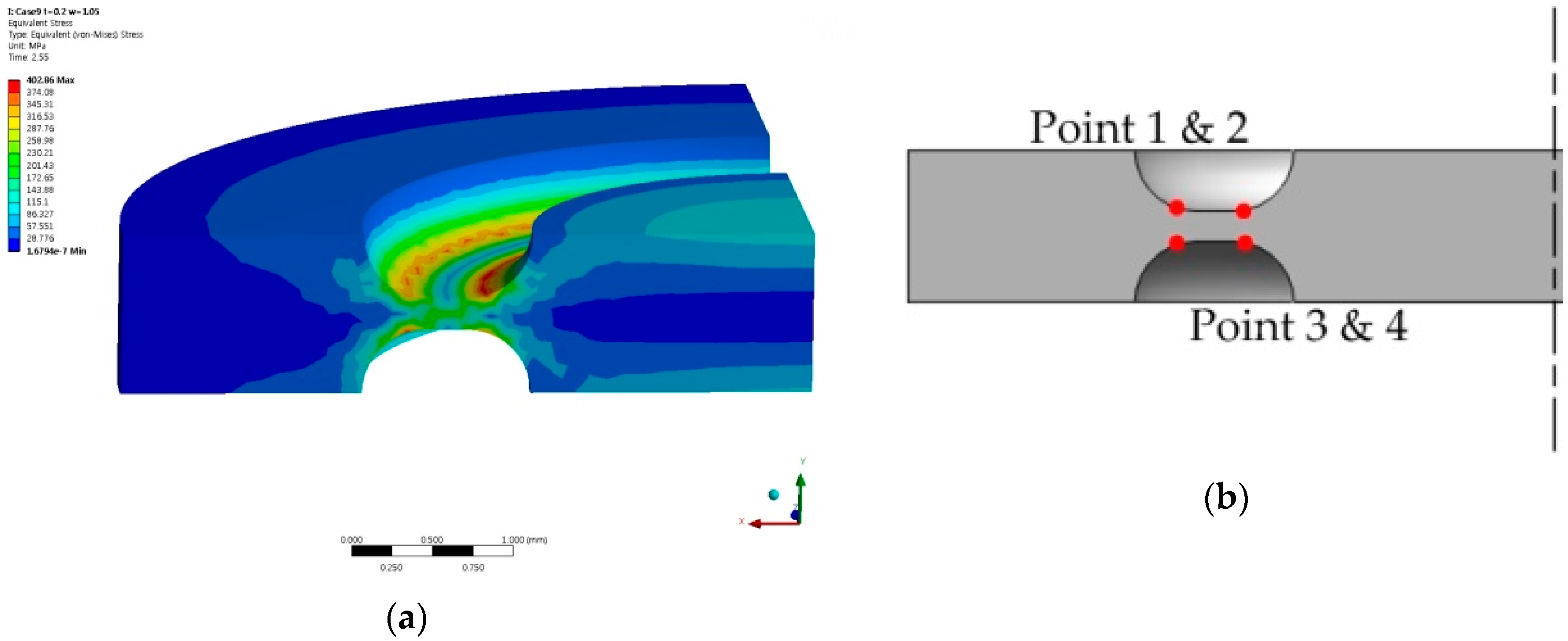
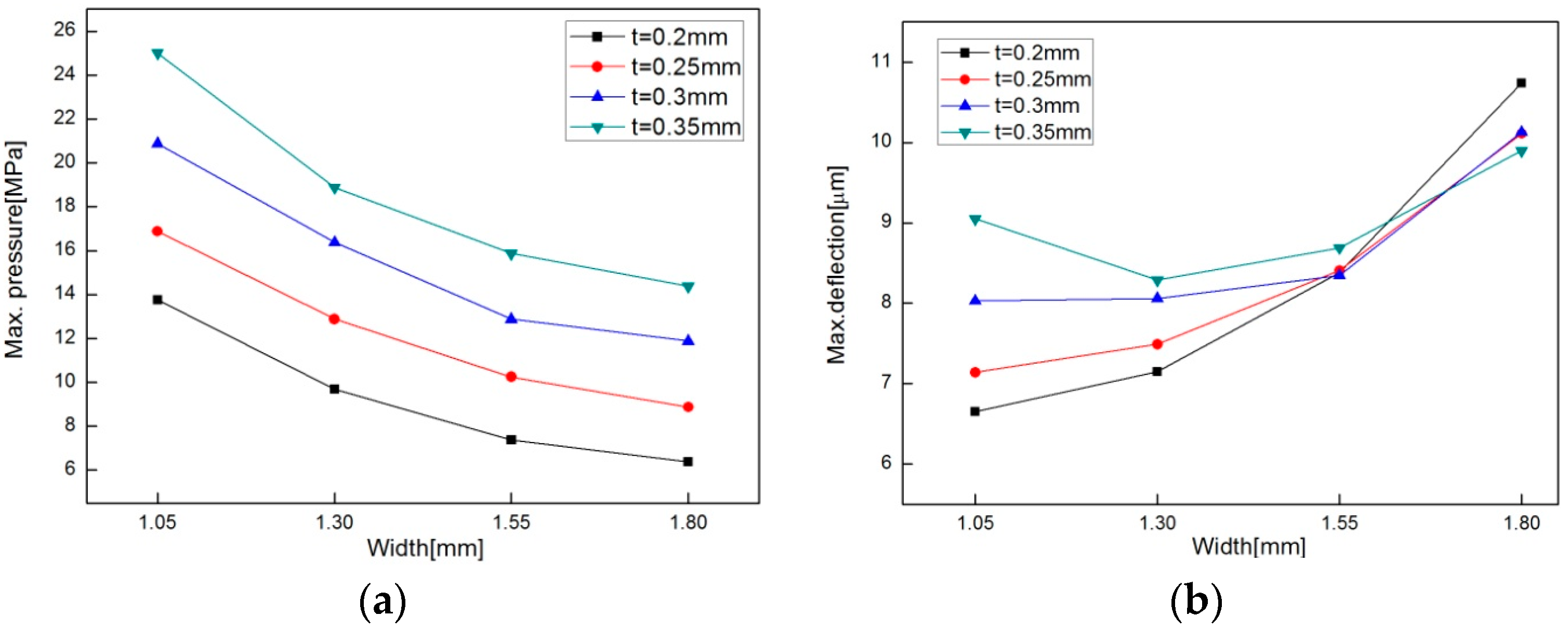
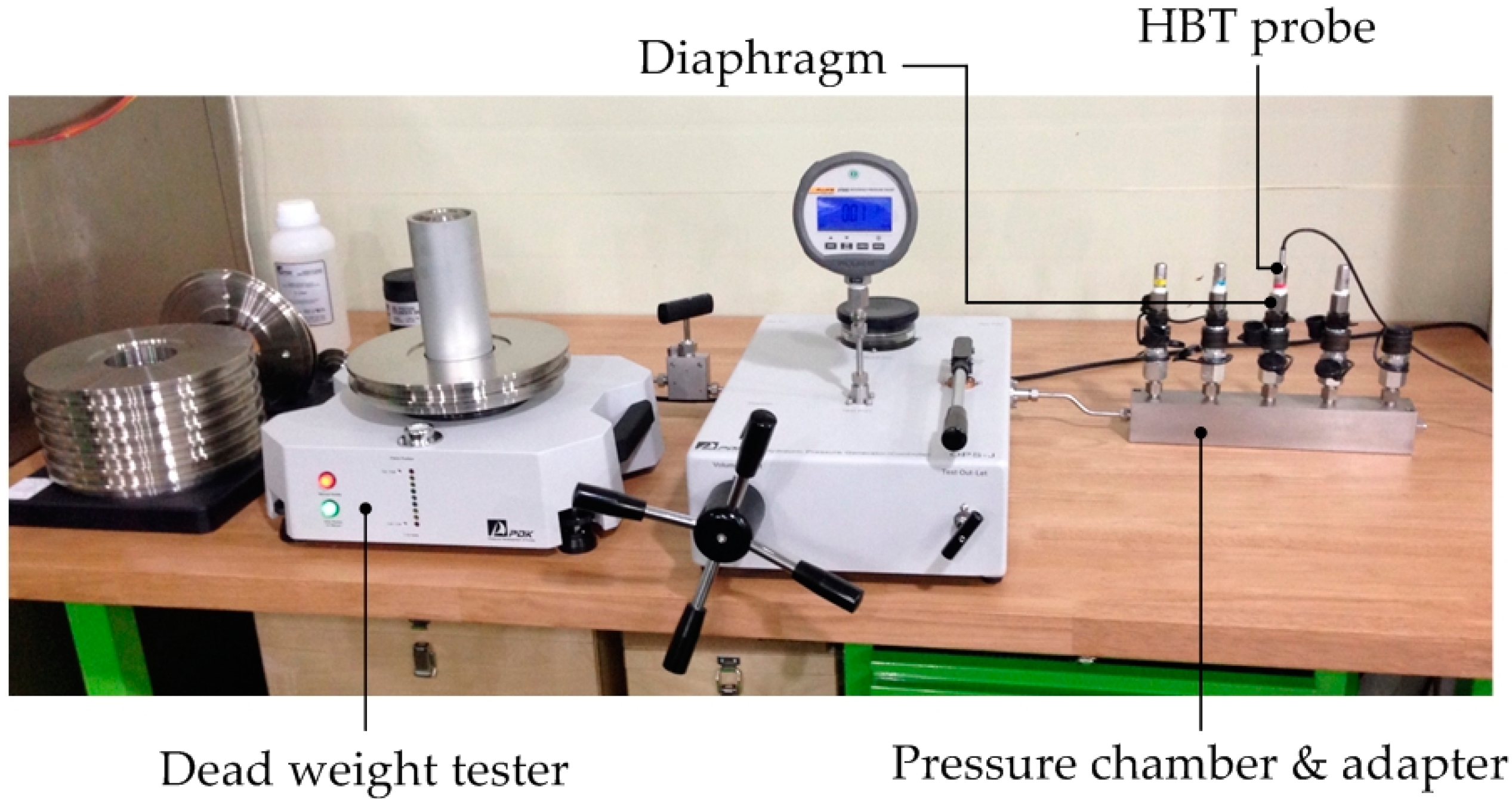
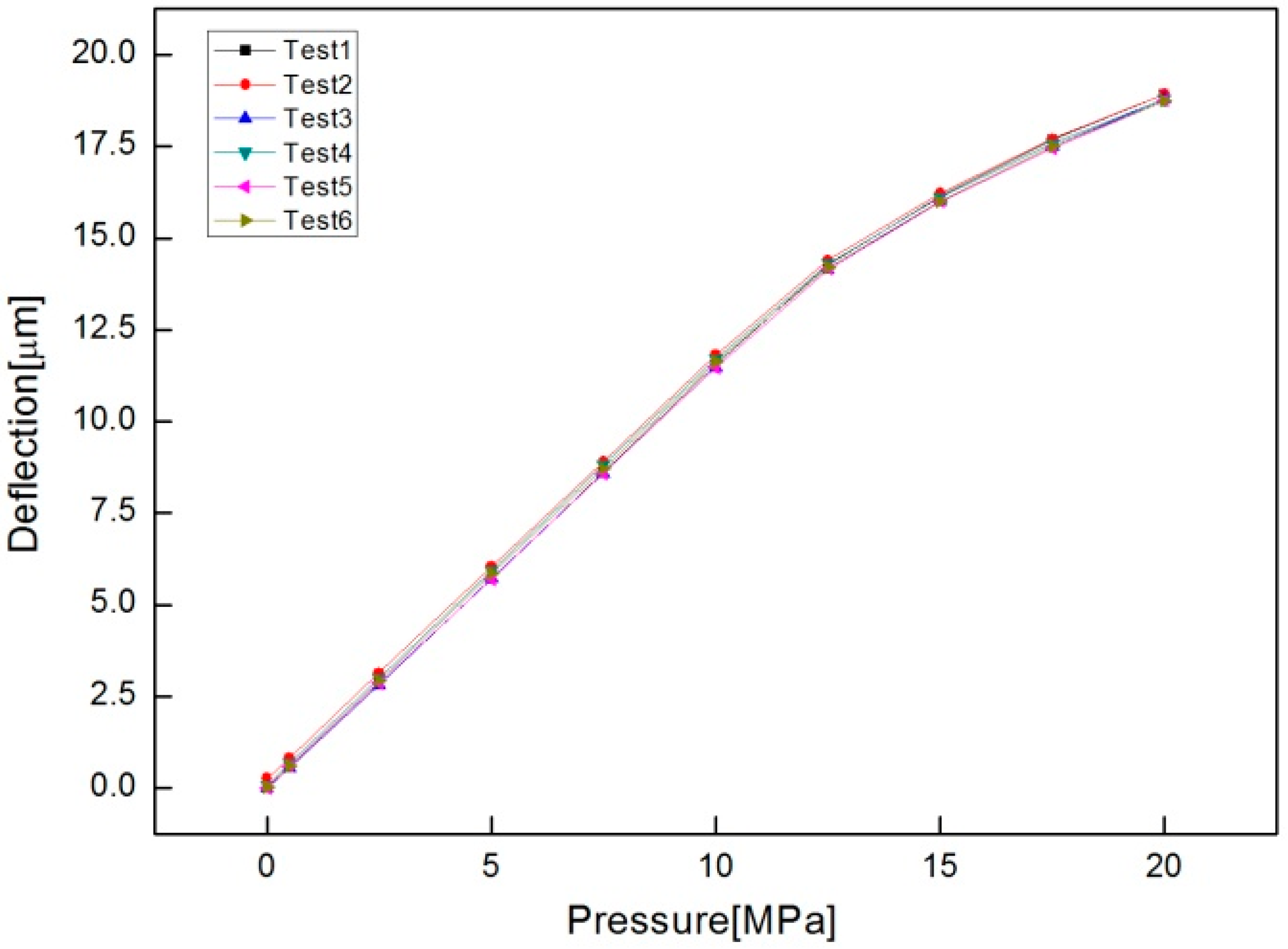
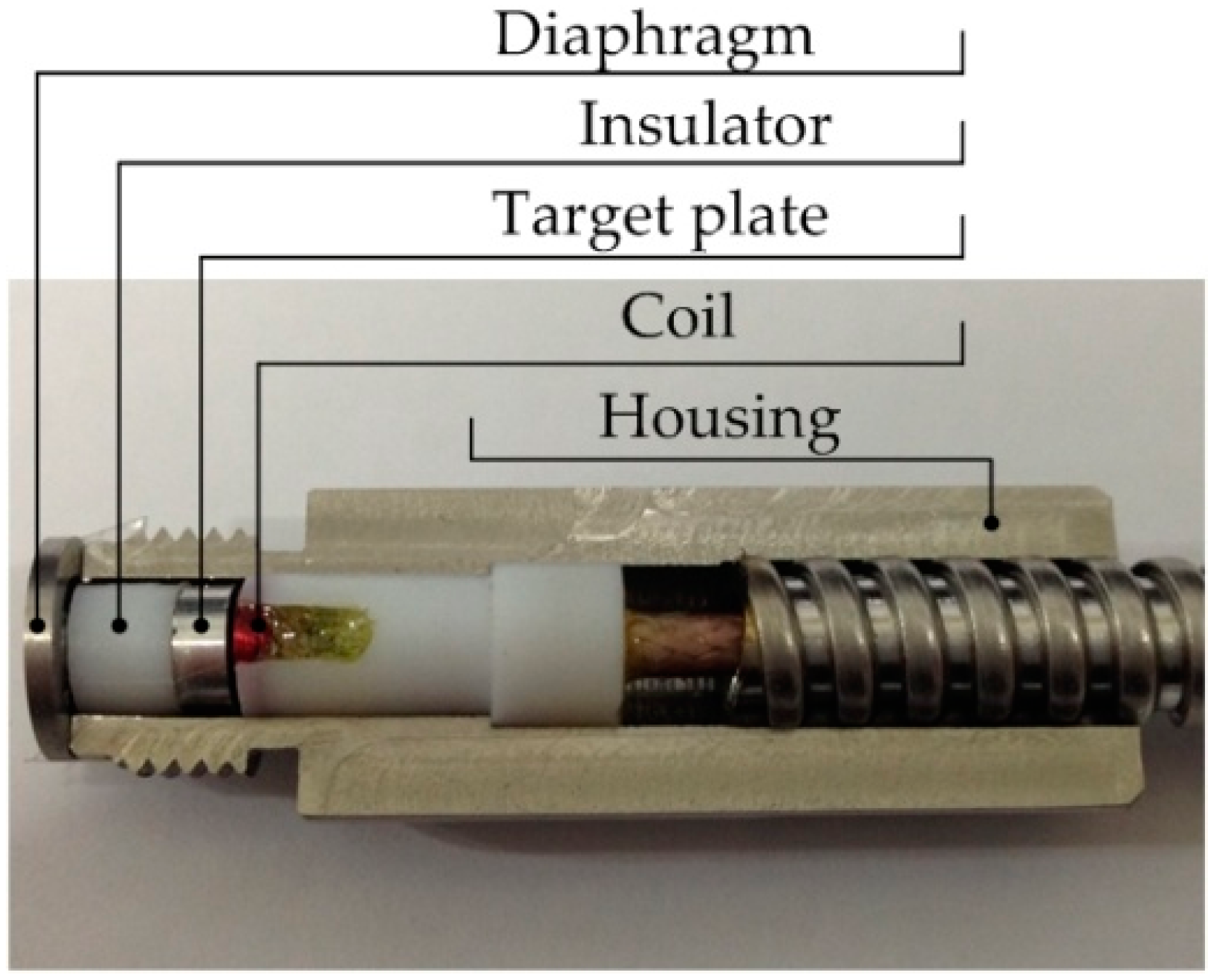
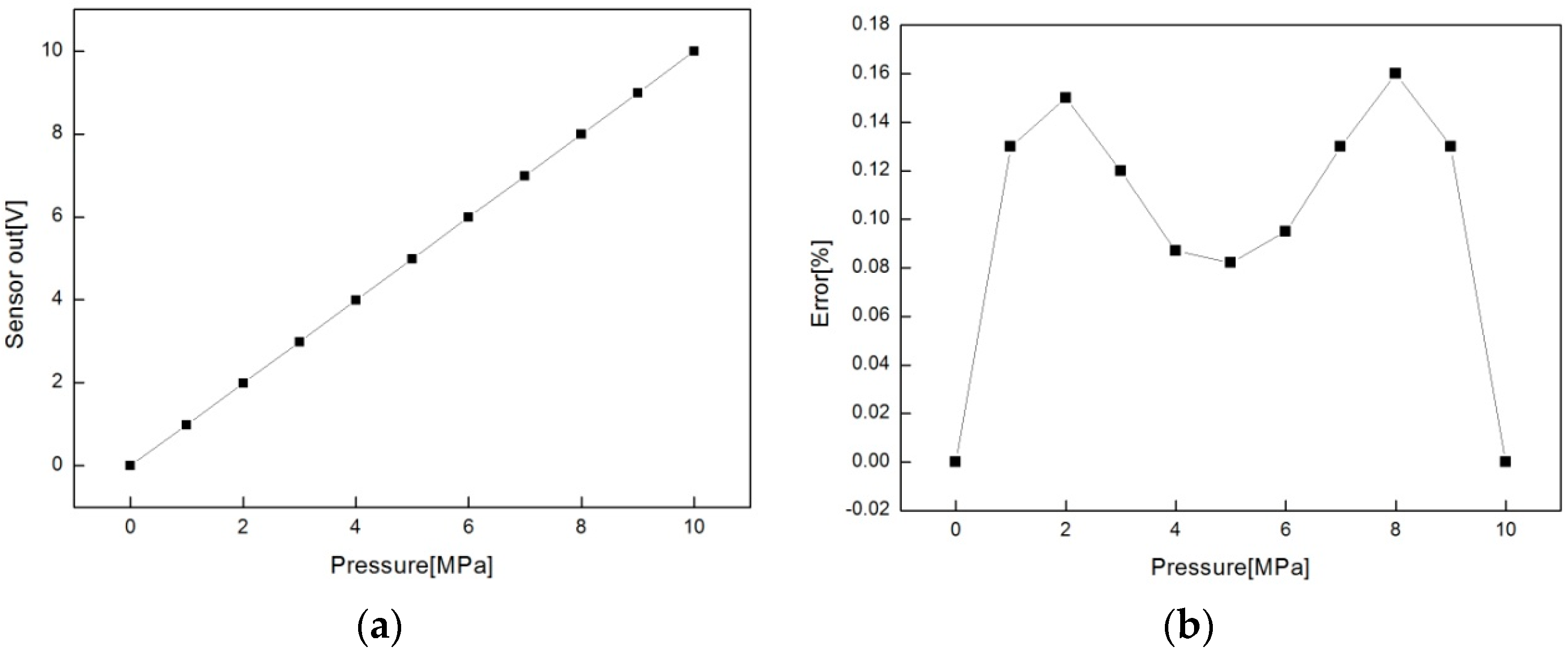
| Thichness (mm) | Width (mm) | Max. Pressure (MPa) | Max. Deflection (μm) | Sensitivity (μm/MPa) | |
|---|---|---|---|---|---|
| Case 1 | 0.20 | 1.05 | 13.75 | 6.65 | 0.48 |
| Case 2 | 0.20 | 1.30 | 9.68 | 7.15 | 0.74 |
| Case 3 | 0.20 | 1.55 | 7.38 | 8.38 | 1.14 |
| Case 4 | 0.20 | 1.80 | 6.38 | 10.74 | 1.68 |
| Case 5 | 0.25 | 1.05 | 16.88 | 7.14 | 0.42 |
| Case 6 | 0.25 | 1.30 | 12.88 | 7.49 | 0.58 |
| Case 7 | 0.25 | 1.55 | 10.25 | 8.41 | 0.82 |
| Case 8 | 0.25 | 1.80 | 8.88 | 10.11 | 1.14 |
| Case 9 | 0.30 | 1.05 | 20.88 | 8.03 | 0.38 |
| Case 10 | 0.30 | 1.30 | 16.38 | 8.06 | 0.49 |
| Case 11 | 0.30 | 1.55 | 12.88 | 8.35 | 0.65 |
| Case 12 | 0.30 | 1.80 | 11.88 | 10.13 | 0.82 |
| Case 13 | 0.35 | 1.05 | 25.00 | 9.05 | 0.36 |
| Case 14 | 0.35 | 1.30 | 18.88 | 8.29 | 0.44 |
| Case 15 | 0.35 | 1.55 | 15.88 | 8.69 | 0.55 |
| Case 16 | 0.35 | 1.80 | 14.38 | 9.90 | 0.69 |
| Pressure (MPa) | Test 1 (μm) | Test 2 (μm) | Test 3 (μm) | Test 4 (μm) | Test 5 (μm) | Test 6 (μm) | Average | Standard Deviation |
|---|---|---|---|---|---|---|---|---|
| 0.0 | 0.00 | 0.26 | 0.00 | 0.09 | 0.00 | 0.02 | 0.06 | 0.10 |
| 0.5 | 0.57 | 0.82 | 0.56 | 0.68 | 0.59 | 0.61 | 0.64 | 0.10 |
| 2.5 | 2.85 | 3.14 | 2.82 | 3.00 | 2.85 | 2.93 | 2.93 | 0.12 |
| 5.0 | 5.70 | 6.05 | 5.72 | 5.94 | 5.70 | 5.85 | 5.83 | 0.15 |
| 7.5 | 8.60 | 8.90 | 8.59 | 8.82 | 8.58 | 8.72 | 8.70 | 0.14 |
| 10.0 | 11.55 | 11.81 | 11.47 | 11.7 | 11.48 | 11.63 | 11.61 | 0.13 |
| 12.5 | 14.27 | 14.4 | 14.15 | 14.3 | 14.16 | 14.21 | 14.25 | 0.10 |
| 15.0 | 16.14 | 16.22 | 16.01 | 16.11 | 16.00 | 16.02 | 16.08 | 0.09 |
| 17.5 | 17.69 | 17.71 | 17.50 | 17.58 | 17.47 | 17.50 | 17.57 | 0.11 |
| 20.0 | 18.94 | 18.94 | 18.80 | 18.8 | 18.76 | 18.76 | 18.83 | 0.09 |
| Pressure (MPa) | Impedance Change (mΩ) | Sensor Output (V) | Error (%) |
|---|---|---|---|
| 0 | 0.00 | 0.00 | 0.00 |
| 1 | 11.66 | 0.98 | 0.13 |
| 2 | 23.45 | 1.99 | 0.15 |
| 3 | 35.29 | 2.99 | 0.12 |
| 4 | 47.14 | 3.99 | 0.09 |
| 5 | 58.96 | 4.99 | 0.08 |
| 6 | 70.75 | 5.99 | 0.10 |
| 7 | 82.52 | 6.99 | 0.13 |
| 8 | 94.30 | 7.99 | 0.16 |
| 9 | 106.14 | 8.99 | 0.13 |
| 10 | 118.10 | 10.00 | 0.00 |
© 2016 by the authors; licensee MDPI, Basel, Switzerland. This article is an open access article distributed under the terms and conditions of the Creative Commons Attribution (CC-BY) license (http://creativecommons.org/licenses/by/4.0/).
Share and Cite
Lee, H.R.; Lee, G.S.; Kim, H.Y.; Ahn, J.H. Design of Diaphragm and Coil for Stable Performance of an Eddy Current Type Pressure Sensor. Sensors 2016, 16, 1025. https://doi.org/10.3390/s16071025
Lee HR, Lee GS, Kim HY, Ahn JH. Design of Diaphragm and Coil for Stable Performance of an Eddy Current Type Pressure Sensor. Sensors. 2016; 16(7):1025. https://doi.org/10.3390/s16071025
Chicago/Turabian StyleLee, Hyo Ryeol, Gil Seung Lee, Hwa Young Kim, and Jung Hwan Ahn. 2016. "Design of Diaphragm and Coil for Stable Performance of an Eddy Current Type Pressure Sensor" Sensors 16, no. 7: 1025. https://doi.org/10.3390/s16071025
APA StyleLee, H. R., Lee, G. S., Kim, H. Y., & Ahn, J. H. (2016). Design of Diaphragm and Coil for Stable Performance of an Eddy Current Type Pressure Sensor. Sensors, 16(7), 1025. https://doi.org/10.3390/s16071025





